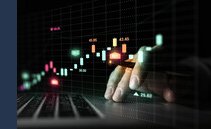The big mistake often made when defining asset allocation is believing that one can obtain a higher return without taking on greater risks.

When it comes to investing our savings, we all want the best: the best fund, the best-performing ETF, and the ideal portfolio. After all, no one wants to miss out on the best opportunities.
However, as hard as it is to accept, trying to achieve perfection at all costs often leads to the opposite results: the more we try to optimize our asset allocation, the more we risk obtaining unsatisfactory results. In this article, we will explore why and how to avoid falling into this trap of perfectionism.
The term "asset allocation" refers to capital distribution among the various financial instruments available, commonly called "portfolio".
By combining different asset classes, such as stocks, gold, and bonds, it is possible to modulate the risk and return of the portfolio. The goal is to create a strategy that allows us to reach our financial goals in the most comfortable way possible.
The big mistake that is often made when defining the asset allocation is to believe that you can obtain a higher return without taking on greater risks, or reduce risk without sacrificing part of the return.
To better understand this concept, we can take as an example a classic balanced portfolio, divided equally between stocks and bonds, and compare it with more complex combinations that maintain the same proportion between risky assets and defensive assets.
Let’s start by further diversifying the equity component, adding emerging market and small-cap stocks, and obtaining a more complex portfolio: 30% stocks, 10% emerging markets, 10% small caps and 50% bonds. Looking at the long term, we will notice that the overall return does not vary significantly compared to the initial portfolio.
If we then add another defensive asset such as gold, obtaining a mix of 30% stocks, 10% emerging markets, 10% small caps, 25% bonds, and 25% gold, again there are no clear benefits in the long term.
Continuing with the addition of another risky asset, REITs (real estate), we can structure an even more complex portfolio, but the result continues to be similar to the starting one.
leggi anche
These 2 tech stocks can make you a millionaire

Often, when building a portfolio, it is thought that seeking perfection is the key to maximizing returns. However, this obsession hides an illusion: no perfect portfolio can completely protect us from the uncertainties and volatility of financial markets. Even the most refined strategy will not protect us from fluctuations.
Just as wearing a pair of running shoes will not automatically make us fitter, a seemingly perfect portfolio will not guarantee results without volatility. In the end, we will still have to deal with the market.
Instead of striving for perfection, it may be wiser to accept a certain degree of imperfection. While targeting specific sectors or geographic areas can certainly lead to quick gains, diversification remains the most effective method of ensuring that you have future winners in your portfolio. In bear markets, defensive assets such as bonds and cash, which might seem superfluous in periods of growth, become strategic instead.
A "good enough" asset allocation allows us to devote resources and energy to equally important factors, without falling into the trap of perfectionism.
Striving for perfection is a mirage while finding balance is a real achievement. Risk and return are two sides of the same coin: the more risk we take, the higher the return could be, and vice versa. However, this does not mean that increasing risk always leads to greater returns. Building a portfolio requires time, awareness, and, above all, balance.
Original article published on Money.it Italy 2024-09-12 07:37:00. Original title: Perché l’asset allocation perfetta non esiste?




